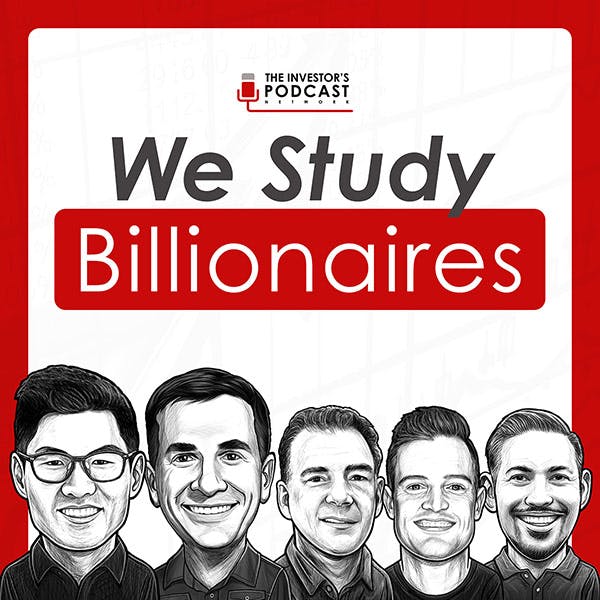
October 11, 2024 • 1hr 0min
TIP667: Why Most Stocks Will Lose You Money w/ Professor Hendrik Bessembinder
We Study Billionaires - The Investor’s Podcast Network

Key Takeaways
- Only 4% of US listed companies generated all of the net wealth creation in the stock market since 1926. This extreme skewness in returns highlights how difficult but potentially rewarding stock picking can be.
- The majority of individual stocks (about 4 out of 7) underperform Treasury bills in terms of compound returns over long time periods. This is despite stocks as an asset class significantly outperforming Treasury bills.
- Net income growth is the most important factor in determining which stocks end up being big long-term winners. Companies that can consistently grow their earnings tend to deliver the strongest returns.
- Even top-performing stocks experience significant drawdowns. For example, Apple had three 70%+ drawdowns despite being the biggest wealth creator from 1981-2019.
- Technology stocks are not more likely to be top performers compared to other sectors. Healthcare/pharma and energy stocks were slightly more likely to be top performers.
- The skewness in stock returns becomes more pronounced over longer time horizons, becoming very noticeable at the decade level and beyond.
- International stock markets show similar or even more extreme levels of return skewness compared to the US market.
- Lower leverage and having a founder CEO are characteristics associated with better long-term stock performance.
Introduction
In this episode, host Clay Finck interviews Professor Hendrik Bessembinder about his renowned research on the performance of individual stocks. Bessembinder is a finance professor at Arizona State University whose paper "Do Stocks Outperform Treasury Bills?" has generated significant attention in the investment community.
The discussion covers Bessembinder's key findings on the extreme skewness of stock market returns, characteristics of top-performing stocks, implications for investors, and how the results vary across different time periods and geographies. The conversation provides valuable insights for both active stock pickers and passive index investors.
Topics Discussed
Origins and Key Findings of the Research (1:58)
- Bessembinder stumbled upon this research when noticing negative average logarithmic returns for a large sample of stocks
- The study found extreme positive skewness in stock returns, especially over long time horizons
- Only 4% of US stocks accounted for all net wealth creation since 1926
- The majority of individual stocks (57%) underperformed Treasury bills
- "If I had labeled that original paper 'Stock Returns are Skewed', I just don't think it would have caught people's attention the same way that the actual title did." - Hendrik Bessembinder
Explaining the Skewness in Stock Returns (10:26)
- Compounding of returns naturally leads to positive skewness over time
- Limited liability caps downside at -100% while upside is unlimited
- Some stocks can generate returns of thousands or even millions of percent over very long periods
- This asymmetry becomes more pronounced over longer time horizons
Why Stocks Outperform Treasury Bills (12:47)
- Economic theory suggests investors need to be compensated for taking on additional risk
- The equity risk premium has historically been quite large (around 8% annually)
- There is ongoing debate about how reliable the equity premium will be going forward
- Active investors buying undervalued stocks and selling overvalued ones help make the market more efficient
Drawdowns of Top Performing Stocks (15:02)
- Even the biggest long-term winners experience significant drawdowns
- Apple had three 70%+ drawdowns despite being the top wealth creator from 1981-2019
- Amazon experienced a 90% drawdown at one point
- Top 100 stocks by decade had average maximum drawdowns of 33% within the same decade
- In the decade before becoming top performers, these stocks had average max drawdowns of 52%
Characteristics of Top Performing Stocks (20:57)
- Net income growth is the most important factor in determining which stocks end up as big winners
- Top performers tend to grow their fundamentals like assets, cash balances, and profitability
- Technology stocks are not more likely to be top performers compared to other sectors
- Healthcare/pharma and energy stocks were slightly more likely to be top performers
- Valuation metrics like P/E ratios did not have predictive power for identifying future top performers
What it Takes to be a Stock Picker (34:28)
- Bessembinder emphasizes the importance of having a comparative advantage
- It's not enough to be smart - you need to be better than your competitors
- The market is highly competitive with many skilled participants
- Active stock pickers need the psychological and financial ability to withstand significant drawdowns
- "To be a successful stock picker, you've got to be good and you've got to be better than your competitors. Comparative advantage is the key issue." - Hendrik Bessembinder
Top Performing US Stocks Since 1925 (45:17)
- Altria was the top performer, compounding at 16.2% from 1925-2023 for a total return of 265 million percent
- Vulcan Materials was second, compounding at 14% for a 39 million percent total return
- Other top performers included Boeing, S&P Global, Coca-Cola, Deere, Hershey, and Johnson & Johnson
- The highest compound returns were around 13-16% annually sustained over very long time periods
- Extremely high short-term returns (50%+ annually) are not sustainable long-term
International Stock Market Skewness (51:48)
- International markets show similar or even more extreme levels of return skewness compared to the US
- The concentration of returns in a small number of stocks was even stronger outside the US
- Differences in listing standards across exchanges and countries likely contribute to varying levels of skewness
- Bessembinder believes strong return skewness is a fundamental attribute of investing in entrepreneurial economies globally
Conclusion
Professor Bessembinder's research provides valuable insights into the nature of stock market returns that have important implications for investors. The extreme positive skewness in returns, with only a small percentage of stocks driving the majority of market gains, highlights both the potential rewards and difficulties of stock picking.
For active investors, the research emphasizes the importance of being able to identify companies with strong earnings growth potential and the ability to sustain that growth over long time periods. It also underscores the need to be prepared for significant drawdowns, even among top-performing stocks.
For passive investors, the findings provide support for broad diversification to increase the odds of capturing the relatively few big winners that drive overall market returns. The research also helps explain why index funds have historically outperformed the majority of active managers.
Ultimately, Bessembinder's work doesn't definitively argue for either active or passive approaches, but rather provides ammunition for both sides of the debate. It highlights the potential for outsized returns from successful stock picking while also showing how difficult it is to consistently identify the top performers in advance.
The professor's ongoing research continues to shed new light on the nature of stock market returns across different time periods, geographies, and company characteristics. His work serves as an important contribution to our understanding of financial markets and the challenges and opportunities facing investors.









